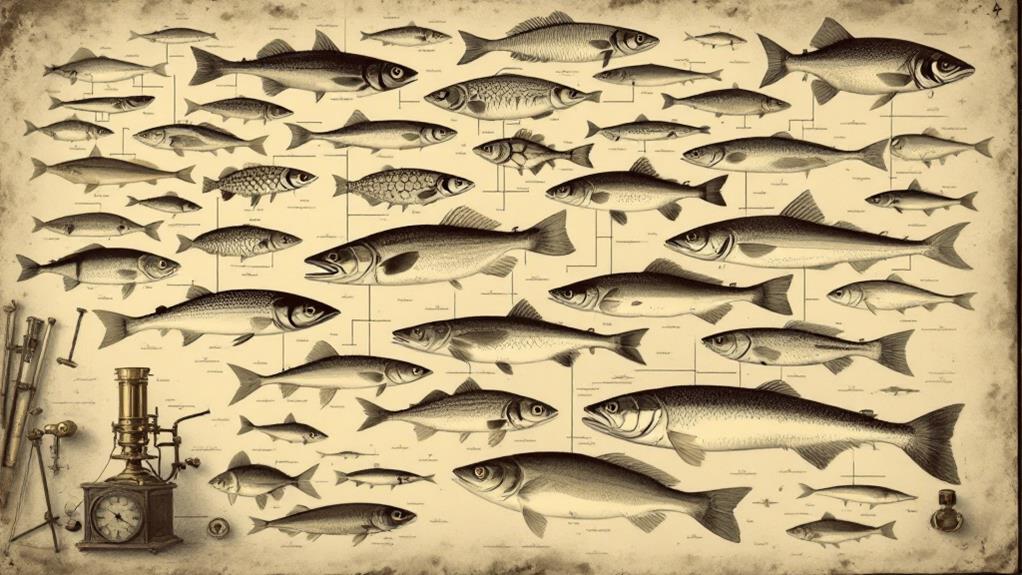The History of Ichthyology: Exploring the Science of Fish

Ichthyology, the study of fish, has a rich history spanning centuries. You'll find its roots in ancient civilizations' fascination with aquatic life, evident in cave paintings and early texts. During the Renaissance, scientific inquiry advanced the field, with figures like Rondelet making significant contributions. Linnaeus's taxonomic system revolutionized fish classification, while Darwin's evolutionary theory provided a new framework for understanding fish diversity. Modern ichthyology employs state-of-the-art technologies, from genomics to underwater robotics, to scrutinize fish biology, ecology, and conservation. As you plunge into this fascinating field, you'll uncover a world of scientific discovery beneath the waves.
Ancient Observations and Early Classifications
From the depths of antiquity, humans have been fascinated by fish. You'll find evidence of this in ancient cave paintings and artifacts depicting various aquatic species. Early civilizations, like the Egyptians, Greeks, and Chinese, made significant observations about fish anatomy and behavior.
In ancient Egypt, you'd see fish hieroglyphics and detailed representations in tomb art. The Greeks, particularly Aristotle, made substantial contributions to early ichthyology. He classified over 100 species of Mediterranean fish and described their aquatic habitats. Aristotle's work laid the foundation for future scientific examination.
Chinese scholars also made remarkable observations. You'll find detailed accounts of fish species in ancient texts like the "Classic of Mountains and Seas." These early classifications were often based on practical uses, such as food sources or medicinal properties.
As you investigate further, you'll uncover that Roman naturalists like Pliny the Elder expanded on Greek knowledge. They compiled extensive catalogs of known fish species, incorporating information from various Mediterranean and European aquatic habitats. These early efforts in fish classification set the stage for more systematic approaches in later centuries.
Renaissance and Enlightenment Contributions
The Renaissance ushered in a novel phase of scientific inquiry, breathing fresh life into ichthyology. You'll find that during this period, naturalists began to approach fish study with renewed vigor and systematic methods. Advances in anatomy allowed for more detailed examinations of fish structures, leading to improved classifications and understanding of their biology.
As you investigate this era, you'll encounter influential figures like Guillaume Rondelet and Ulisse Aldrovandi, who made significant contributions to ichthyological knowledge. Their works, filled with detailed illustrations and descriptions, laid the groundwork for future research.
The Enlightenment brought further progress, with Carl Linnaeus introducing his revolutionary taxonomic system. However, this period wasn't without its challenges. Taxonomic controversies arose as scientists debated the best ways to classify fish species. You'll notice that these disagreements ultimately drove the field forward, encouraging more rigorous observation and analysis.
During this time, you'd have seen the emergence of specialized tools and techniques for studying fish, including improved microscopes and preservation methods. These advancements allowed for more accurate documentation and comparison of species, setting the stage for modern ichthyology.
Linnaean Taxonomy and Systematic Ichthyology

Carl Linnaeus's introduction of binomial nomenclature in the mid-18th century marked a turning point in ichthyology. His system of naming organisms using two Latin words revolutionized the way scientists classified and studied fish. You'll find that this standardized approach made it easier to communicate about different species across languages and cultures.
Linnaeus's work laid the foundation for systematic ichthyology, which focuses on the classification and naming of fish species. As you plunge into this field, you'll uncover that it relies heavily on anatomical classification. Scientists examine fish structures, such as fins, scales, and skeletal features, to determine relationships between species and create taxonomic groups.
The Linnaean system's impact on ichthyology can't be overstated. It allowed researchers to organize the vast diversity of fish species into a hierarchical structure, from kingdom down to species. This systematic approach has enabled ichthyologists to better understand fish evolution, ecology, and biodiversity. As you venture deeper into the history of ichthyology, you'll see how Linnaeus's work continues to influence modern fish research and conservation efforts.
Darwin's Impact on Fish Studies
Following in the footsteps of Linnaeus, Charles Darwin's revolutionary theory of evolution by natural selection greatly impacted fish studies in the 19th century. His work challenged existing beliefs about species' origins and relationships, prompting ichthyologists to reevaluate their understanding of fish diversity and adaptation.
Darwin's evolutionary theory provided a framework for explaining the vast array of fish species and their unique characteristics. You'll find that his ideas revolutionized how scientists approached fish classification, morphology, and behavior. Natural selection became a key concept in understanding how fish adapted to various aquatic environments.
Darwin's impact on fish studies can be seen in several areas:
- Comparative anatomy of fish species
- Study of fish adaptations to different habitats
- Understanding of fish distribution patterns
- Analysis of fish fossils and their evolutionary significance
As you investigate the history of ichthyology, you'll notice that Darwin's work sparked new research directions and methodologies. Scientists began to examine fish populations through the lens of evolutionary theory, leading to groundbreaking discoveries about speciation, adaptation, and biodiversity in aquatic ecosystems. This shift in viewpoint continues to shape modern ichthyology and our understanding of fish evolution.
Modern Research Methods and Technologies

Advancing rapidly, modern ichthyology has adopted state-of-the-art research methods and technologies that have revolutionized our understanding of fish biology, ecology, and evolution. You'll find that genetic sequencing has become a cornerstone of fish research, allowing scientists to unravel complex evolutionary relationships and identify cryptic species. This powerful tool has shed light on fish population structures and migration patterns, essential for conservation efforts.
Population modeling has also emerged as a crucial technique in ichthyology. By combining data on fish abundance, distribution, and environmental factors, researchers can now predict how fish populations will respond to various pressures, such as climate change or overfishing. These models help inform management decisions and conservation strategies.
Other cutting-edge technologies you'll encounter in modern ichthyology include acoustic telemetry for tracking fish movements, environmental DNA sampling for detecting species presence, and high-resolution imaging techniques for studying fish anatomy. Advanced computer algorithms and machine learning are increasingly used to analyze vast datasets, revealing patterns and ideas that were previously undetectable. These innovations continue to push the boundaries of our knowledge about fish and their ecosystems.
Conservation and Ecological Significance
Through the lens of conservation, ichthyology has taken on pivotal importance in recent decades. As you probe the field, you'll find that fish play a vital role in maintaining healthy aquatic ecosystems. Their significance extends beyond their immediate habitats, impacting entire food webs and even terrestrial environments.
Conservation efforts in ichthyology focus on:
- Endangered species management
- Habitat restoration initiatives
- Sustainable fishing practices
- Invasive species control
You'll uncover that ichthyologists are at the forefront of developing strategies to protect vulnerable fish populations. They're working tirelessly on endangered species management, implementing breeding programs and monitoring population dynamics. Habitat restoration initiatives are crucial, as they aim to recreate or preserve the environments fish need to thrive.
As you delve deeper into the field, you'll comprehend how ichthyology contributes to broader ecological studies. Fish serve as indicators of water quality and ecosystem health. By studying their behavior, migration patterns, and population changes, you're gaining insightful knowledge into the overall state of aquatic environments. This understanding is essential for developing effective conservation strategies and ensuring the long-term survival of diverse fish species and their ecosystems.
Future Directions in Ichthyology

As you look ahead, the field of ichthyology is positioned for pioneering advancements. You'll witness the integration of emerging genomic techniques, revolutionizing our understanding of fish evolution, adaptation, and biodiversity. These tools will enable you to uncover hidden genetic diversity and resolve longstanding taxonomic debates.
You'll see a shift towards community-based management strategies in fisheries conservation. This approach will empower local communities to actively participate in fish conservation efforts, ensuring sustainable practices that benefit both ecosystems and livelihoods.
Climate change will drive research into fish resilience and adaptation. You'll plunge into how warming waters and changing ocean chemistry affect fish populations, migration patterns, and reproduction. This knowledge will be essential for developing effective conservation strategies.
Advancements in underwater imaging and robotics will allow you to study fish in their natural habitats with unparalleled detail. You'll gain perceptions into fish behavior, ecology, and interactions that were previously inaccessible.
Lastly, you'll witness the growing importance of interdisciplinary collaboration. Ichthyologists will increasingly work alongside climatologists, geneticists, and data scientists to address complex challenges facing fish populations worldwide.



